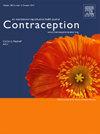马萨诸塞州妇产科医生提供药物流产和程序流产的情况。
IF 2.8
2区 医学
Q1 OBSTETRICS & GYNECOLOGY
引用次数: 0
摘要
目标:了解马萨诸塞州妇产科医生(OB/GYNs)提供头三个月药物流产和程序流产的比率、流产培训的充分性以及与提供流产服务相关的因素:研究设计:对 2021 年马萨诸塞州的妇产科医生进行电子实地普查,询问医生是否提供人工流产服务、培训、执业类型和人口统计数据。利用加权法考虑非响应因素,我们得出了提供人工流产服务的妇产科医生比例的估计值,并利用多变量回归分析探讨了与提供人工流产服务相关的因素,包括执业类型、医生性别和是否接受过充分的人工流产培训:198名妇产科医生对调查做出了回复(回复率=29%)。在 158 名未接受过培训的妇产科医生中,55% 的医生提供了一些人工流产护理。报告接受过充分手术流产培训的受访者(84%)多于接受过药物流产培训的受访者(43%)。不提供人工流产护理的最主要原因是没有融入临床实践(29%)、机构反对(27%)或个人反对人工流产(23%)。在多变量分析中,女医生更有可能提供人工流产护理(aOR 2.72,95% CI [1.63-4.55],P< 0.01),而那些培训不足的医生更不可能提供人工流产护理(aOR 0.18,95% CI [0.10-0.33],P=0.01)。私人诊所(aOR 0.47,95% CI [0.28-0.80],P< 0.01)或 "其他 "诊所类型(aOR 0.16,95% CI [0.09-0.27],P< 0.01)的医生与学术诊所的医生相比提供人工流产的可能性较低:结论:在支持人工流产的州,只有一半的妇产科医生提供人工流产服务。结论:在支持人工流产的州中,只有一半的妇产科医生提供人工流产服务。尽管患者对药物流产的兴趣很高,但大多数妇产科医生表示药物流产方面的培训不足。本文章由计算机程序翻译,如有差异,请以英文原文为准。
Provision of medication and procedural abortion among Massachusetts obstetrician-gynecologists
Objectives
The aim of the study was to understand the rates of first-trimester medication and procedural abortion provision, sufficiency in abortion training, and factors associated with abortion provision among obstetrician-gynecologists (OB/GYNs) in Massachusetts.
Study design
Electronically fielded surveys of a census of OB/GYNs in Massachusetts in 2021 queried physicians on abortion provision, training, practice type, and demographics. Using weighting to account for nonresponse, we generated estimates of the proportion of OB/GYNS providing abortion and used multivariate regression analysis to explore factors associated with abortion provision including practice type, physician sex, and sufficient abortion training.
Results
A total of 198 OB/GYNs responded to the survey (response rate = 29%). Of 158 OB/GYNs not in training, 55% provide some abortion care. More respondents reported sufficient training for surgical abortion (84%) than for medication abortion (43%). The most cited reasons for not providing abortion care were lack of integration into their clinical practice (29%), institutional opposition (27%), or personal opposition to abortion (23%). In multivariate analysis, female physicians were more likely to provide abortion care (adjusted odds ratio [aOR] 2.72, 95% CI [1.63–4.55], p < 0.01), and those with insufficient training less likely to provide abortion (aOR 0.18, 95% CI [0.10–0.33], p = 0.01). Those in private practice (aOR 0.47, 95% CI [0.28–0.80], p < 0.01) or “other” practice types (aOR 0.16, 95% CI [0.09–0.27], p < 0.01) were less likely to provide abortion compared to physicians in academic practices.
Conclusions
Only half of OB/GYNs in a state supportive of abortion provide abortion. Despite high patient interest in medication abortion, a majority of OB/GYNs report insufficient training in medication abortion.
Implications
This study highlights the need for support from practice, institution, and health system leaders to facilitate the provision of abortion care and the need for increased training among OB/GYNs in medication abortion.
求助全文
通过发布文献求助,成功后即可免费获取论文全文。
去求助
来源期刊

Contraception
医学-妇产科学
CiteScore
4.70
自引率
17.20%
发文量
211
审稿时长
69 days
期刊介绍:
Contraception has an open access mirror journal Contraception: X, sharing the same aims and scope, editorial team, submission system and rigorous peer review.
The journal Contraception wishes to advance reproductive health through the rapid publication of the best and most interesting new scholarship regarding contraception and related fields such as abortion. The journal welcomes manuscripts from investigators working in the laboratory, clinical and social sciences, as well as public health and health professions education.
 求助内容:
求助内容: 应助结果提醒方式:
应助结果提醒方式:


